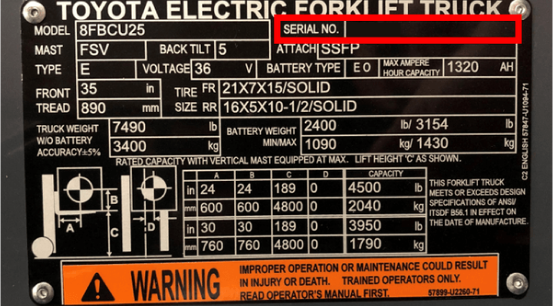How to Get a Credit Line for Financing a Forklift

Sifting through various material handling equipment to find the right forklift for your specific needs, applications, and work volume can be a rewarding process that improves operations. As a business owner or manager, you’ll eventually identify the right forklift that fits your business. Great! But to get that forklift into your operation, you’ll have several financing options to choose from. If you aren’t paying for the equipment with cash in full, then opening a credit line for financing is a great next step in getting your forklift.
To apply for a credit line, you should first gather the information the financial institution needs. Having this information prepared will help speed up the credit application process, meaning you can focus on solving your material handling challenges.
Here is some information you should have ready:
Employer Identification Number (EIN)
Your business’s Employer Identification Number (EIN) is also known as your Federal Employer Identification Number (FEIN) or federal tax ID. EIN works like your Social Security Number (SSN) but for your business. EIN allows your business to apply for credit, and financial institutions will use your EIN to run your company’s credit history. If your business is a sole proprietorship business, the financial institution will look at your personal credit report as well.
Trade References
Financial institutions may require you to provide trade references in addition to the credit application to get a credit line. Before extending credit, sellers and financial institutions use trade references to ensure the buyer is capable of paying the debts in full. A good trade reference is a company from whom you acquire products or services and with whom you have a good financial standing. Wholesalers, accountants, and automobile leasing companies are all examples of potential trade references. If you are in good financial standing with them and have a long-standing relationship, they are likely to count you as a reliable financial partner.
Typically, you must provide up to three trade references with any given application. Trade references can drastically influence your company’s ability to get a credit line.
Financial History
Financial institutions use your financial history to see if your business is profitable and has a positive cash flow. Usually, the profitability and other financial ratios will determine your business's credit line interest rates and the size of the credit line. Financial institutions use time in business to help determine whether to give you a credit line, as this showcases a company's stability. Statistically, most companies go out of business within their first five years in operation; because of this, financial institutions may be hesitant to provide a sizeable line of credit to a newer company. High profitability and excellent trade references can help mitigate the risk a financial institution sees in a newer company. If the company has limited credit, be prepared to provide bank statements or 2 to 3 years' worth of your company's financials. Any institution's credit evaluation would likely need documents such as tax returns or CPA-prepared or audited Balance Sheets, Income statements, or P&L statements to assess the business better. Proper paperwork will showcase the business's ability to pay or even how much capacity the business has for financing.
While each financial institution and different financing tools, like various lease types and long-term rentals, will have their specific requirements, the above categories of information are usually required in any financing deal. Being prepared and having a good grasp on what you need before you search for a credit line will help your procurement of forklifts go much smoother.
Your local Toyota Forklift Dealer is available to help you secure the best solution for your fleet while ensuring the process for obtaining a line of credit is as seamless as possible.


